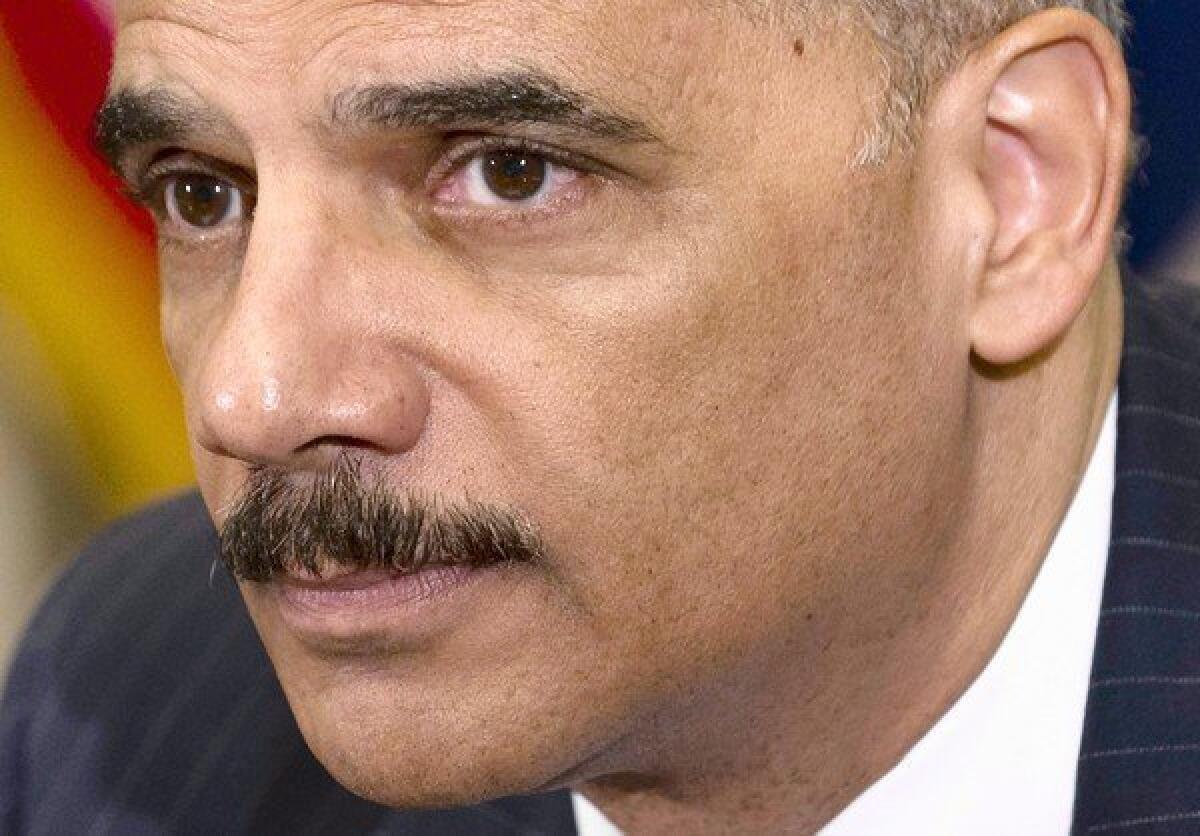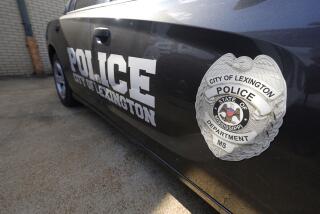Inquiry assigns blame in Fast and Furious; 2 officials quit

WASHINGTON â A gun-trafficking investigation on the Southwest border that went awry was a âsignificant danger to public safety,â according to an independent government report that recommended that the Department of Justice consider disciplining 14 officials, from field agents in Arizona to top managers in Washington.
Less than an hour after those findings were announced, two of the officials â Kenneth E. Melson, the former acting head of the Bureau of Alcohol, Tobacco, Firearms and Explosives; and Deputy Assistant Atty. Gen. Jason M. Weinstein â announced they were stepping down. Others cited included Assistant Atty. Gen. Lanny Breuer, who runs the Justice Department criminal division, and Gary Grindler, who was the No.2 Justice official during Operation Fast and Furious.
The findings on Fast and Furious and a smaller program called Wide Receiver were announced Wednesday by the Justice Departmentâs inspector generalâs office. Fast and Furious allowed more than 2,000 illegally purchased firearms to circulate across the U.S.-Mexico border.
The 18-month investigation also concluded that Atty. Gen. Eric H. Holder Jr. had no knowledge of the problems surrounding Fast and Furious before the slaying of a U.S. Border Patrol agent brought them to light. He has long held that position despite intense criticism from Republican lawmakers who voted him in contempt of Congress for refusing to turn over some Justice documents regarding Fast and Furious.
The report marks the end of the last formal investigation of the long-running controversy. Though it probably will continue to pop up in court skirmishes over the Holder contempt citations as well as in campaign ads, it appears to put to bed the central Republican allegation that Holder and the Obama White House were involved.
The inspector general
determined that ATF agents and federal prosecutors had enough evidence to arrest and charge Jaime Avila, a Phoenix gun smuggler, months before U.S. Border Patrol Agent Brian Terry was killed near Tucson in December 2010. Two of the weapons Avila illegally purchased were recovered at the scene of the killing.
Fast and Furious, said Inspector Gen. Michael E. Horowitz, was implemented by the ATF and the U.S. Attorneyâs office âwithout adequate regard for the risk it posed to public safety in the United States and Mexico.â He said that although officials hoped to track the weapons to Mexican drug cartel leaders, it was nonetheless a ârisky strategy without adequately taking into account the significant danger to public safety that it created.â
Holder said the job performances of the dozen cited in the report and still employed at the ATF and the Justice Department would be reviewed with the âconsideration of potential personnel actions.â He declined to elaborate, citing privacy restrictions.
The attorney general also fired back at what he said were âunsubstantiated conclusionsâ by Republican lawmakers and other conservatives who have alleged that Holder and possibly some Obama White House officials not only were aware of the unorthodox tactics but condoned them.
âIt is unfortunate that some were so quick to make baseless accusations before they possessed the facts about these operations, accusations that turned out to be without foundation and that have caused a great deal of unnecessary harm and confusion,â Holder said.
But House Oversight and Government Reform Committee Chairman Darrell Issa (R-Vista) said the report âconfirms findings by Congressâ investigation of a near total disregard for public safety in Operation Fast and Furious.â He said the investigation found there were âred flags showing reckless tactics and faults Attorney General Eric Holderâs inner circle for their conduct.â
Fast and Furious was born in the fall of 2009 in the ATFâs Phoenix field office and the U.S. Attorneyâs office there. It was similar to Operation Wide Receiver, which began during George W. Bushâs presidency and was smaller, involving only 400 firearms.
Already feeling criticized for making individual arrests rather than concentrating on large gun rings, agents and prosecutors came up with a broader idea of allowing many more weapons to be illegally purchased in the hope of tracking the firearms and arresting cartel leaders.
As it turned out, because Fast and Furious was largely run by a team of just three agents, the report said, the ATF could not keep up with the flood of weapons suddenly flying off the shelves of Phoenix-area gun stores once smugglers realized they were not being stopped or questioned.
As the inspector general put it, the ATF and federal prosecutors were overwhelmed and âfailed to conduct the investigation with the urgency, oversight and attention to public safety that was required.â
Making matters worse, a directive in March 2010 from the ATF in Washington to come up with an âexit strategyâ and announce some arrests was not followed. It was not until January 2011, a month after Agent Terry was killed, that 20 alleged straw purchasers and gun traffickers were arrested. Most of them have since pleaded guilty.
Hope MacAllister, a lead agent in Fast and Furious, believed she needed an admission of guilt from the gun smugglers before she could make any arrests, and the inspector generalâs office said it was âtroubledâ that she did not show more urgency in stopping the operation.
Her boss, William Newell, then head of the ATF field office in Phoenix, âbore the ultimate responsibility for the failures in Operation Fast and Furious,â the report said. The inspector general noted that he was often âdefensiveâ when questioned by Washington superiors about the growing number of firearms getting away. His conduct, the report said, was âirresponsibleâ and âhe failed to provide the leadership and judgment required of a special agent in charge.â
In Washington, Melson, then head of the ATF, was cited for not managing the Phoenix case more closely, and the inspector general said his overall leadership during Fast and Furious was âdeficientâ in not trying to push the investigation to a close. Melson was moved to a smaller job after Fast and Furious became publicly known, and as soon as the findings were announced Wednesday, Melson said he was retiring after almost 30 years of federal service.
âI firmly disagree with many of the speculative assumptions, conclusions and characterizations in the inspector generalâs report,â Melson said. But âas the acting director of the agency I was ultimately responsible for the actions of each employee.â
At the Department of Justice, Weinstein said in a resignation letter to Holder that it was âso personally painful for meâ to read the inspector generalâs conclusion that he knew guns were going into the hands of criminals and did not try to stop it. âFor me to have done this would have run counter to the entire body of work I compiled during the past 15 years,â he wrote.
The report said Breuer failed to warn Holder about Wide Receiver and that Grindler learned that Fast and Furious weapons were recovered after Terry was killed but also did not tell Holder.
At ATF headquarters, Melsonâs replacement, Acting Director B. Todd Jones, said structural problems in the agency and a lack of communication were behind much of Fast and Furious. That has changed now, he said.
âWe have taken corrective actions to ensure that something like this never happens again,â he said. âWe will make sure that this agency puts public safety first in all of our investigations.â
David G. Savage in the Washington bureau contributed to this report.
More to Read
Sign up for Essential California
The most important California stories and recommendations in your inbox every morning.
You may occasionally receive promotional content from the Los Angeles Times.











